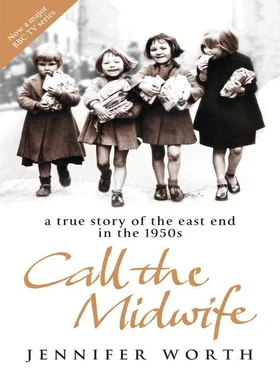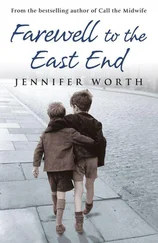By the 1950s, most houses had running cold water and a flushing lavatory in the yard outside. Some even had a bathroom. The tenements, however, did not, and the public wash-houses were still very much in use. Grumbling boys were taken there once a week to have a bath by determined mothers. The men, probably under female orders, carried out the same weekly ablution. You would see them going to the bath-house on a Saturday afternoon with a small towel, a piece of soap, and a dour expression, which spoke of a weekly tussle once again waged and lost.
Most houses had a wireless, but I did not see a single TV set during my time in the East End, which may well have contributed to the size of the families. The pubs, the men’s clubs, dances, cinemas, the music halls and dog racing were the main forms of relaxation. For the young people, surprisingly, the church was often the centre of social life, and every church had a series of youth clubs and activities going on every night of the week. All Saints Church in the East India Dock Road, a huge Victorian church, had many hundreds of youngsters in its youth club run by the Rector and no less than seven energetic young curates. They needed all their youth and energy to cope, night after night, with activities for five or six hundred young people.
The thousands of seamen of all nationalities that came into the docks did not seem to impinge much upon the lives of the people who lived there. “We keeps ourselves to ourselves,” the locals said, which meant no contact. Daughters were carefully protected: there were plenty of brothels to cater for the needs of the seamen. In my work I had to visit two or three of them, and I found them very creepy places to be in.
I saw prostitutes soliciting in the main roads, but none at all in the little streets, even on the Isle of Dogs, which was the first landing place for the seamen. The experienced professional would never waste her time in such an unpromising area, and if any enthusiastic amateur had been rash enough to attempt it, she would soon have been driven out, probably with violence, by the outraged local residents, men as well as women. The brothels were well known, and always busy. I daresay they were illegal, and raided from time to time by the police, but that did not seem to affect business. Their existence certainly kept the streets clean.
Life has changed irrevocably in the last fifty years. My memories of the Docklands bear no resemblance to what is known today. Family and social life has completely broken down, and three things occurring together, within a decade, ended centuries of tradition - the closure of the docks, slum clearance, and the Pill.
Slum clearance started in the late 1950s, while I was still working in the area. No doubt the houses were a bit grotty, but they were people’s homes and much loved. I remember many, many people, old and young, men and women, holding a piece of paper from the Council, informing them that their houses or flats were to be demolished, and that they were to be rehoused. Most were sobbing. They knew no other world, and a move of four miles seemed like going to the ends of the earth. The moves shattered the extended family, and children suffered as a result. The transition also literally killed many old people who could not adapt. What is the point of a spanking new flat with central heating and a bathroom, if you never see your grandchildren, have no one to talk to, and your local, which sold the best beer in London, is now four miles away?
The Pill was introduced in the early 1960s and modern woman was born. Women were no longer going to be tied to the cycle of endless babies; they were going to be themselves. With the Pill came what we now call the sexual revolution. Women could, for the first time in history, be like men, and enjoy sex for its own sake. In the late 1950s we had eighty to a hundred deliveries a month on our books. In 1963 the number had dropped to four or five a month. Now that is some social change!
The closure of the docks occurred gradually over about fifteen years, but by about 1980 the merchant ships came and went no more. The men clung to their jobs, the unions tried to defend them, and there were numerous dockers’ strikes during the 1970s, but the writing was on the wall. In fact the strikes, far from protecting jobs, merely accelerated the closures. For the men of the area, the docks were more than a job, even more than a way of life - they were, in fact, life itself - and for these men, the world fell apart. The ports, which for centuries had been the main arteries of England, were no longer needed. And therefore the men were no longer needed. This was the end of the Docklands as I knew them.
In the Victorian era, social reform had swept through the country. For the first time authors wrote about iniquities that had never before been exposed, and the public conscience was stirred. Among these reforms, the need for good nursing care in hospitals gained the attention of many farsighted and educated women. Nursing and midwifery were in a deplorable state. It was not considered a respectable occupation for any educated woman, and so the illiterate filled the gap. The caricature figures of Sairey Gamp and Betsy Prig - ignorant, filthy, gin-swilling women - created by Charles Dickens, may seem hilarious as we read about them, but would not have been funny if you had been obliged, through poverty, to place your life in their hands.
Florence Nightingale is our most famous nurse, and her dynamic organisational skills changed the face of nursing for ever. But she was not alone, and the history of nursing records many groups of dedicated women who devoted their lives to raising the standards of nursing. One such group was the Midwives of St Raymund Nonnatus, 1They were a religious order of Anglican nuns, devoted to bringing safer childbirth to the poor. They opened houses in the East End of London, and in many of the slum areas of the great industrial cities of Great Britain.
In the nineteenth century (and earlier, of course) no poor woman could afford to pay the fee required by a doctor for the delivery of her baby. So she was forced to rely on the services of an untrained, self-taught midwife, or “handywoman” as they were often called. Some may have been quite effective practitioners, but others boasted a frightening mortality rate. In the mid-nineteenth century, maternal mortality amongst the poorest classes stood at around 35-40 per cent, and infant mortality was around 60 per cent. Anything like eclampsia, haemorrhage, or mal-presentation, would mean the inevitable death of the mother. Sometimes these handywomen would abandon a patient to agony and death if any abnormality developed during labour. There is no doubt that their working practices were insanitary, to say the least, and thereby spread infection, disease and often death.
Not only was there no training, but there was also no control over the numbers and practice of these handywomen. The Midwives of St Raymund saw that the answer to this social evil lay in the proper training of midwives and control of their work by legislation.
It was in the struggle for legislation that these feisty nuns and their supporters encountered the fiercest opposition. From about 1870 the battle raged; they were called “an absurdity”, “time wasters”, “a curiosity”, and “an objectionable body of busy-bodies”. They were accused of everything from perversion to greed for unlimited financial gain. But the Nonnatus Nuns would not be put down.
For thirty years the battle continued, but in 1902 the first Midwives Act was passed and the Royal College of Midwives was born.
The work of the Midwives of St Raymund Nonnatus was based upon a foundation of religious discipline. I have no doubt that this was necessary at the time, because the working conditions were so disgusting, and the work so relentless, that only those with a calling from God would wish to undertake it. Florence Nightingale records that when she was in her early twenties she saw a vision of Christ, telling her that her life was required for this work.
Читать дальше












